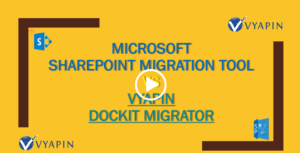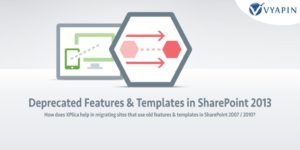Introduction
SharePoint migration is a process that many organizations undergo when they need to upgrade their collaboration and document management systems. Whether you are moving from an older version of SharePoint to a newer one, or transitioning from a different platform altogether, a successful migration can lead to improved collaboration, enhanced security, and better integration with other Microsoft products. This blog post will guide you through the key steps and considerations for a successful SharePoint migration, including planning, methods, tools and validation.
Why Migrate to SharePoint?
SharePoint offers a robust platform for collaboration and document management with robust security measures built-in. It integrates seamlessly with Microsoft Office, making it easy for teams to work together on documents, spreadsheets, and presentations. Additionally, SharePoint’s advanced security features help protect sensitive information, while its customizable nature allows it to fit the unique needs of any organization. Customization is the strong point of SharePoint and it offers various options to customize at the levels of Look and Feel (UX), Intranets, Workflows, Automation using schedulers and so on. SharePoint also offers features like version control, advanced search, and workflow automation that can help improve productivity.
Pre-Migration Planning
Before starting the migration process, it is important to conduct a thorough audit of your current content. Identify what needs to be moved, what can be archived, and what can be deleted. This is also a good time to identify any necessary customizations for your new SharePoint environment. Finally, setting up a migration schedule will help ensure that the process has minimal impact on your organization’s day-to-day operations. It is also crucial to communicate with your team about the upcoming changes and provide training on how to use the new system.
Here is a checklist to run through for planning your SharePoint migration:
- Understanding the Source Environment
- The migration team must have a comprehensive understanding of thesource environment, which typically means the following:
- Inventory: Knowing the structure, size, and quality of content to be migrated.
- Customizations: Identifying any customizations in the source environment.
- Content Bloat: Assessing whether the migration can remove unnecessary content.
- The migration team must have a comprehensive understanding of thesource environment, which typically means the following:
- Key Considerations Before Migration
- Visibility of Content: Ensure complete visibility of all content in the source platforms. Visibility means the migration tools have the right user permissions to access such content, there are no hardware or software restrictions on the content to be moved, and any other security related restrictions.
- Organizational Objectives: Validate if content and collaboration objectives will be met. This is perhaps a bit more of a documentation exercise, outlining all migrated and integrated content meet the collaboration objectives such as content sharing, communication, workflows and so on.
- Consultant vs. In-House IT: Decide whether external consultants or in-house IT staff are needed. SharePoint is not simple to put together when there are advanced collaboration and communication requirements. In such cases, SharePoint experts may offer valuable benefits even if they come at a cost.
- Migration Approach Optimization: Optimize the migration approach for time and effort. This means how exactly the different tasks and batches of migration are set up so that migration performance is adequate. Content needs to be moved and it takes time to move different types of content as it might involve migrating different versions, setting up appropriate access control when the content is getting moved and so on.
- Governance, Security, and Accessibility: Set up the destination SharePoint environment with these critical factors in mind. Governance is all about organizational compliance is met and appropriate maintenance controls and measures and put in place.
- Cost Estimation: Having a sound migration plan allows estimating total costs. This is perhaps the most important one from a management standpoint to ensure there are no budget overruns and licensing plans have been properly estimated for purchase when moving to SharePoint. A migration plan must include all associated costs of migration and moving to production.
- Rollback Plan: Prepare a temporary rollback plan in case the migration faces challenges. A well-planned migration may not need this, but a contingency plan must be available if there are unforeseen difficulties when moving content from source to the target, and there are demanding production deadlines that need to be met so that there are no production disruptions affecting the business of the organization.
Choosing the Right SharePoint Migration Tool
There are several SharePoint migration tools available, each with its own strengths and weaknesses. Some tools are better suited for large-scale migrations, while others are better for smaller, more targeted migrations. Consider factors such as cost, ease of use, and the specific needs of your migration when choosing a SharePoint migration tool. It’s also worth considering whether you need a tool that can handle migrations from non-SharePoint systems.
Consultants vs. Third-Party Tools
Consultants: Hiring consultants can be beneficial for SharePoint architecture planning and hassle-free migration.
Third-Party Tools: Sophisticated third-party SharePoint migration tools for SharePoint and Microsoft 365 offer capabilities that may be useful for in-house staff performing large migrations with complex metadata and content.
There are several third-party tools available in the market. Evaluation of such tools require an in-depth understanding of the SharePoint migration requirements, best practices and related complexities.
Special Considerations when migrating to SharePoint Online
When considering a migration from SharePoint 2010, SharePoint 2013, or SharePoint 2016 to Microsoft 365 SharePoint Online, it is crucial to take into account the following:
- Identify all features in your current SharePoint platform and verify their availability in SharePoint on Microsoft 365.
- Identify the various business-related customizations that you have set up in your On-premise SharePoint versions and explore how they can be carried forward to SharePoint online. Remember that server-side customizations are not possible in SharePoint online.
- Be aware that not all features in your on-premise SharePoint may be present in all Microsoft 365 plans. Some features might not be available at all and some may be available only in Premium Microsoft 365 plans. Understanding Microsoft 365 plans and their features is very important.
- Thoroughly research all Microsoft 365 plans to determine the one that best fits your needs.
- Remember, selecting the appropriate Microsoft 365 plan can result in significant time and cost savings.
This approach ensures a smooth transition and helps you make the most of your SharePoint Online experience.
SharePoint Online Governance Plan
For organizations with established rules and regulations on content access and monitoring, it’s crucial to develop a distinct governance plan for SharePoint Online. This plan should address the key governance areas:
- Access Identification: Determine who has what kind of access to your SharePoint Online. Analyse the access types granted to users and understand the control that site administrators have over users and sites.
- Site Usage Analysis: Conduct a comprehensive analysis of site usage. Identify underutilized sites that may need cleanup or reorganization. Third-party SharePoint Reporting tools can be beneficial in this process.
- Permissions Understanding: Comprehend how permissions are assigned for each site. Site owners should decide whether users access a new site directly or inherit permissions from the parent site.
- Security Planning: Strategize the overall security of your SharePoint Online. Examine how security is handled on each site. Consider whether folders and documents should have unique permissions, which is typically not advised.
- Site Template Usage: Review all available site templates, including custom ones, and understand their deployment purposes.
- Privacy Settings: Familiarize yourself with the privacy settings of My Site profile, Ratings, Tagging, and Status, among others.
- Backup and Restore Needs: Evaluate if your organization needs to backup and restore Office 365. While the cloud generally doesn’t require backup plans due to its inherent protection, your company might need it for specific business needs.
The Migration Process
The actual migration process involves moving data from your current system to SharePoint. It is a good idea to start by backing up your data, then testing the migration with a small dataset. This allows you to identify and address any issues before the full migration. Especially if your migration involves moving content from SharePoint On-premises to Microsoft 365 Cloud it is important to do a few test runs to understand speed of migration, understand issues related to look and feel, workflows and so on. It is also important to ensure that user permissions have all been brought over intact. Doing the first few runs using a good SharePoint Migration tool on small but different flavors of data sets will help iron out any unforeseen issues from the planning stages. During the migration, monitor the process closely to ensure that everything is going smoothly with adequate progress indicators. It is also important to have a contingency plan in place in case something goes wrong.
Post-Migration Steps
While SharePoint migration can be a complex process, careful planning and execution can lead to significant benefits for your organization. By improving collaboration, enhancing security, and providing a platform that can be customized to meet your unique needs, SharePoint is a powerful platform for any organization. Remember, the key to a successful migration is careful planning, clear communication, and ongoing support for users.
Conclusion
While SharePoint migration can be a complex process, careful planning and execution can lead to significant benefits for your organization. By improving collaboration, enhancing security, and providing a platform that can be customized to meet your unique needs, SharePoint is a powerful platform for any organization. Remember, the key to a successful migration is careful planning, clear communication, and ongoing support for users.
This article is written by Vyapin, the makers of DocKIT Migrator, a superior, value-for-money SharePoint migration tool. The content reflects Vyapin’s experience for over two decades in listening to their SharePoint customers and Consultants.






